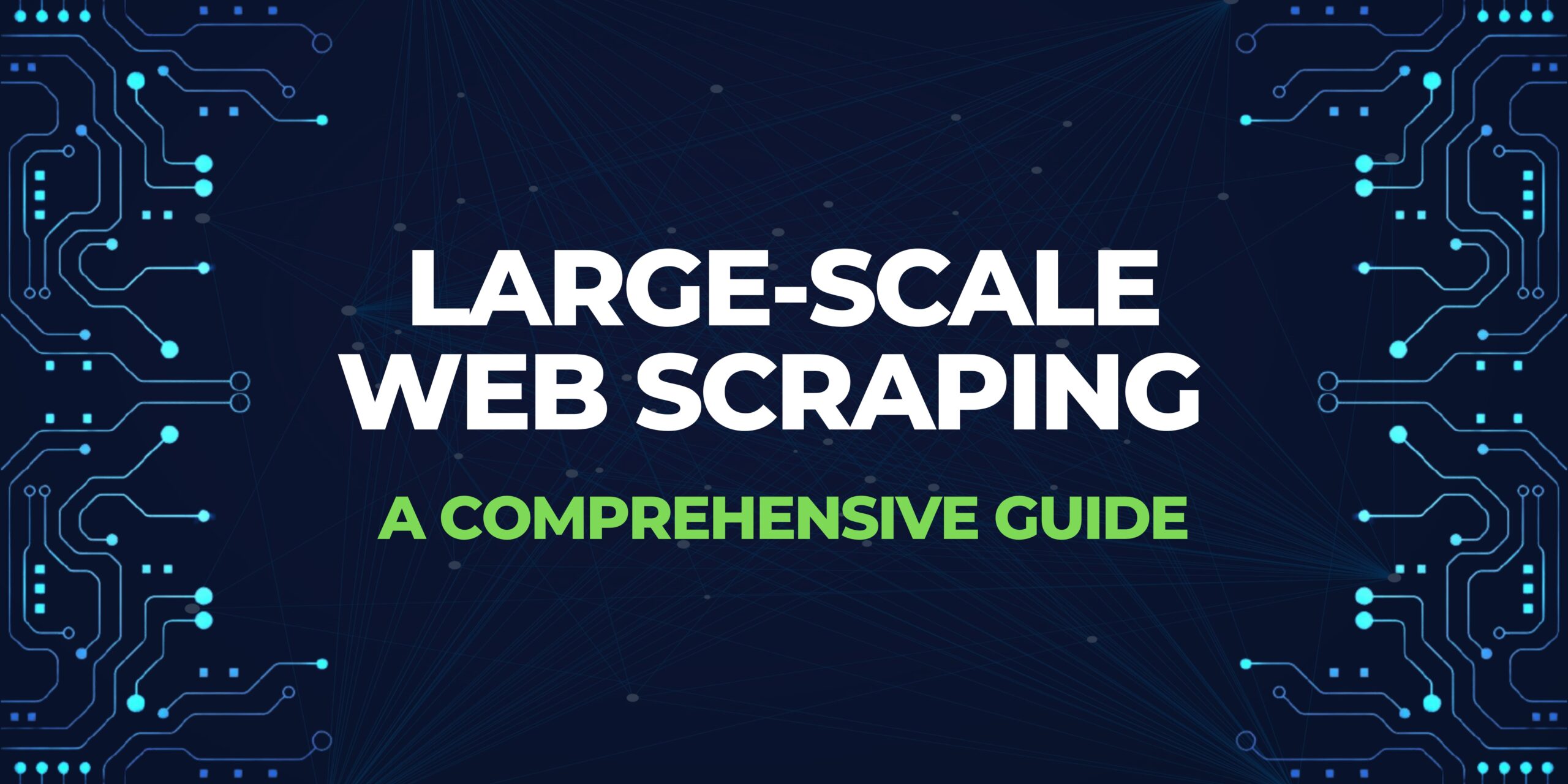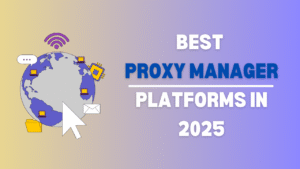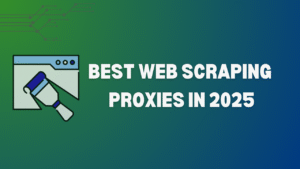Web scraping is an essential tool to have in our current business environment. It allows the user to extract a large amount of data, which helps the user who could be a business owner, a professional, or even a researcher to gain access to insights that allow them to make informed decisions. This blog discusses large-scale web scraping in-depth and the top tools that can be used to extract data.
What is large-scale web scraping?
Simply put, it is scraping a huge number of websites to extract relevant data to help your business.
Types of large-scale web scraping
The two types are:
- Scraping a large website: Scraping and extracting data from a large number of web pages from within a major website such as Amazon, Myntra, or LinkedIn
- Crawling multiple websites: Simultaneously collecting data from 1000s of different small websites
Depending on the tool being used and how strong it is, both these types will effectively get the job done. Large-scale web scraping provides you with a cost-effective method to extract tonnes of data, which in turn helps you make data-driven decisions that would lead to greater product development.
Why do you need to use large-scale web scraping?
It’s used for a multitude of factors such as data analysis, price monitoring, measuring site traffic, and tracking your competition. Information is key and if you have a data-driven business, it becomes all the more important.
The most fool-proof method to scale up your business is to collect as much data as you can and then process that into something that helps boost your cause and gives you an edge over your competitors.
Large-scale web scraping provides you with a cost-effective method to extract tonnes of data, which in turn helps you make data-driven decisions that would lead to greater product development.
If you’re not convinced already, here’s a breakdown of all the wondrous things large-scale web scraping can do and how it can help you grow your business.
1. Saves you money and time:
The use of large-scale web browsing will prevent you from burning a hole through your pocket because using a scraping tool is far more cost-efficient than hiring people to do the same. A tool can do what three humans can do, thereby largely cutting your costs. It also saves you time as automatic data collection and extraction, performed by your tool, is much faster than manual data collection.
2. Helps better market understanding:
Processing large-scale data can give you indications of how the market is functioning and what you can do to further scale your business. It also provides you with access to large amounts of data from multiple sources which lets you monitor your competitors, study the customer’s preferences, collect market data, and track the new trends.
3. Automatic data collection:
Among the biggest advantages of large-scale web scaling is the fact that data is automatically collected by the scraping tools, irrespective of whether you are- around or not. You can simply schedule your tool to gather data at regular intervals and that will ensure you have the most updated and relevant data at your fingertips.
4. Aids in building a better product:
The use of large-scale web scaling helps you track how consumers are reacting to your product and what’s working and what isn’t. You could open up two versions of the same product and see which the consumers are engaging better with, thereby giving you a comprehensive idea of what the consumer wants. It also helps track customer feedback and reviews which the business can use and improve its products.
Top 5 Best Tools for Large-scale Web Scraping
There are plenty of tools around for large-scale web scraping. The following are some of the top choices right now:
1. Scraping Browser
Bright Data is the world’s #1 web data platform and has launched a browser that is specially designed for scraping web data. Presenting to you – Scraping Browser! The first of its kind, this is the only browser that comes with built-in website unblocking capabilities.
Scraping Browser, which runs on common high-level APIs like Puppeteer, can discreetly handle all website unlocking tasks such as getting past CAPTCHA, browser fingerprinting, selecting headers, accepting/rejecting cookies based on Bright Data’s Web Unlocker.
This scraper works on every scale and it can bypass any bot-detection software, making sure we can access any data we need.
Used by a large number of Fortune 500 companies, Scraping Browser offers a free trial for you to get a whiff of the magic they offer.
Sign up for Bright Data’s Scraping Browser
2. Scrapy
Scrapy is a commonly used open-source large-scale data scraping tool that is written in Python and runs on Linux, Windows, Mac and BSD. It’s very versatile in nature as it manages requests, parses HTML web pages, collects data and saves it in the format that works for you.
It also performs other complex functions like scraping data of products from e-commerce sites. Since it’s an open source tool, the data is regularly updated and fresh and it also comes with community-level support.
3. Puppeteer
Puppeteer is a Node.js library which is maintained by the Chrome DevTools team. It gives you a proper browser setup and creates an automated testing environment by employing the latest JavaScript and Chrome features, which is its USP.
Puppeteer can scrape Java-heavy SPAs (Single-Page Applications) and also automate form submission and keyboard input, which helps you bypass anti-scraping tools in a breeze. This Chrome-powered tool is a fantastic option if you’ve chosen JavaScript as your preferred platform.
4. ScrapingBee
ScrapingBee API handles the scraping of data with the use of headless browsers and rotating proxies. It is light, super fast and can render JavaScript to scrape any website. Their large proxy pool reduces the chances of getting blocked by anti-scraping tools and ensures automatic proxy rotation from time to time.
It supports libraries for Python and JavaScript and is perfect for businesses that want to focus on the scraping process and don’t want to stress over proxies or headless browsers. ScrapingBee offers an initial free trial of 1,000 API calls and gives you access to a fully functional Chrome Browser engine.
5. WebScraper
WebScraper has the simplest UI – you can configure the scraper tool by simply pointing your mouse at an element and clicking on it. And that’s it, you have the data ready without the need for any coding. WebScraper is a fine option to extract data from dynamic websites and it has the ability to navigate a website on all levels.
This Chrome-based scraper is ideal for companies that do not have a development team as it requires no code whatsoever. It’s very simple to use and allows you to export data in CSV format directly from your browser.
What are the challenges that come along with large-scale web scraping?
Large-scale web scraping does have a few challenges that you will have to bypass such as different website structures, handling dynamic content, maintaining the quality of data, and getting past anti-scraping measures.
While large-scale web scraping does have certain prerequisites such as powerful systems to collect, process, and store data, here are some of the other bumps you could face –
1. Anti-scraping measures:
Websites do their bit to prevent you from scraping the data on their web pages by using a bunch of anti-scraping measures. To bypass these, you would need to include Captcha and Javascript challenges or other tools to identify block bots. It isn’t impossible to beat these measures, you just need to ensure your scraping tool has the technical capabilities to work around these barricades.
2. Dynamic content:
Few websites use dynamic content that is loaded via JavaScript, AJAX, or APIs. These websites have features like captchas ( clicking on images), and filling a form which makes scraping the content difficult. Your scraping tool will need to be programmed in such a way that it can simulate such interactions to get access to the data on the web page.
3. Differing website structures:
Different websites have different structures – from their layouts and designs to the language used to code. Plus, websites are likely to undergo changes and upgrades at periodic intervals. To counter this, your large-scale web scraper must be updated and programmed regularly to keep up with the changes on the internet and you could even look at making customized scraping programs for different websites.
4. Quality of data:
As the saying goes…too much of anything is too much. Scraping data from websites might be an easy task, but analyzing and classifying it into something meaningful is a challenge and a half. Especially when you’re dealing with aspects such as inconsistent and incomplete data. Going through large datasets is also very time-consuming, so the best approach would be to include automated metrics to validate and check the data for any inaccuracies.
How does large-scale web scraping work?
Large-scale web scraping is the result of a series of functions and processes, performed simultaneously. For example, if you want to scrape data from a product page on Amazon then you need to have multiple processes running at the same time such as a crawler, a scraper, the framework to process the data, and a space to store all the information.
Let’s delve into the steps needed for large-scale web scraping –
- A crawler needs to be set up along with the scraper: A crawling path, which is a collection of URLs from where the data can be scraped needs to be made to start the web scraping process. In order for the scraping process to function smoothly, you will have to create a continuous scraping process that can work on multiple pages simultaneously. Both functions must happen in sync for the best results. In short, your crawlers must identify the pages that have relevant data, and then your scrapers get working on them to extract all the relevant data.
- Proxies: The most important element of this process is the proxies. Websites store data from IP addresses after every request. When it notices there are numerous requests from the same IP, it blocks them. That serves as a big hurdle in the scraping process. A proxy comes into use when we want to mask our location and identity. It also helps achieve a smooth scraping process as it changes the IP address after every request.
- Bypassing bot detectors: Anti-scraping tools have become very common on the internet today. Websites enable anti-bot strategies such as CAPTCHA, where you’re usually presented with nine images and asked to choose the correct ones based on the question posed. For eg: Choose the images that have a fire hydrant. Typically, such tools require humans to solve the puzzle.
- Data warehouse: It’s a no-brainer that large-scale web scraping will yield large amounts of data and we need a location to store all of it. So where can data be stored? If you’re scraping and processing your data in small batches, then you could just use a spreadsheet. However, when you’re processing data in bulk, you will have to look out for options such as MySQL or cloud storage services.
How is large-scale web scraping different from normal web scraping?
While both methods are spokes of the same wheel, what separates large-scale web scraping from normal web scraping is the sheer volume. Large-scale web scraping tools are virtually similar to normal web scraping tools, except they are 100x stronger and faster.
They’re like normal web-scraping tools, but with 10 cups of coffee in them.
Is large-scale web scraping ethical?
Large-scale web scraping is absolutely legal, but how ethical it is depends on your approach to scraping and collecting the data. Flouting websites’ terms of use, breaching their data privacy codes, and adding undue strain on a website’s resources would count as unethical and might not be the best way to collect data.
Here are a few aspects you can adhere to when scraping the web at a large scale –
- Data privacy: Data that is sensitive like your phone numbers, social security numbers, or any other personal identifying information needs to be stored carefully to make sure it’s not breached.
- Respect website policies: Websites may mention a clear diktat on data that is automatically scraped and some websites may even explicitly prohibit the scraping of their data. In such cases, it is advisable to respect the website’s policies and terms of use because violating these terms is unethical and can be considered illegal as well.
- Don’t cause an overload: Large-scale scraping puts a fair amount of strain on a website. However, relentless scraping could cause a server overload which could affect the website’s functioning and also affect the user’s experience, which is an unethical thing to do. Avoid bludgeoning a website’s servers by extensively scraping it.
- Intellectual property rights: Violating Intellectual property rights can get you in trouble with the law, therefore always ensure that you are aware of the laws and not violating them. If needed, seek permission from the owner of the data before using their data because that could attract a lawsuit and is far from ethical.
Frequently Asked Questions (FAQs)
1. What is large-scale web scraping?
Large-scale web is the process of crawling through a vast number of websites to then scrape them for relevant data to help your business.
2. What are the uses of large-scale web scraping?
Large-scale web scraping has multiple uses: to analyze data, monitor price, measure site traffic, track customer sentiment, market research, and aggregate content.
3. Is large-scale web scraping different from normal web scraping?
Large-scale web scraping tools are virtually similar to normal web scraping tools, except they are 100x stronger and faster. The main difference is that large-scale web scraping tools function on sheer volume.
4. What are the benefits of large-scale web scraping?
The many advantages of large-scale web scraping include the fact that it saves you loads of time and money, helps you improve your product development, aids in better market understanding, and facilitates automatic data collection.
5. How do I scrape a large website?
Scraping a large website typically involves two approaches:
- Deep Scraping: Extracting data from thousands of pages within a single large website like Amazon or LinkedIn. This requires robust scraping tools, IP rotation, and handling of pagination, dynamic content, or login barriers.
- Wide Crawling: Collecting specific data from many smaller websites simultaneously. This is useful for aggregating dispersed information across the internet.
To scrape a large website effectively, you need a reliable scraping framework or tool (like Scrapy, Puppeteer, or ScrapingBee), proxy management, and respect for the website’s robots.txt and legal guidelines.
6. Why is large-scale web scraping considered an essential tool in the current business environment?
In today’s data-driven world, large-scale web scraping plays a crucial role in helping businesses make informed decisions. It allows companies to gather vast amounts of data for analysis, competitor tracking, price monitoring, and understanding customer behavior. The more data you can gather and process, the better your chances of gaining a competitive edge.
7. What exactly is large-scale web scraping and how does it differ from standard web scraping?
Large-scale web scraping is the process of crawling through a huge number of websites to collect relevant data for your business. The key difference from regular web scraping lies in the volume—it’s all about scale. While the tools might be similar, large-scale scraping tools are much more powerful, often described as being 100 times stronger and faster than standard tools.
8. What are the main technical challenges one might face when performing large-scale web scraping?
There are several hurdles. One is dealing with different website structures—each site can be built differently, and that changes over time. Then there’s dynamic content, like JavaScript-based elements or forms that load asynchronously. You also need to manage inconsistent data and find ways to get around anti-scraping tools like CAPTCHAs. Plus, you need powerful infrastructure to collect, process, and store all that data.
9. How do large-scale web scraping tools typically handle anti-scraping measures like CAPTCHA?
Websites often use CAPTCHAs and JavaScript challenges to block bots. Tools built for large-scale scraping, like Scraping Browser, are equipped to get past these obstacles. They can simulate human-like behavior, deal with cookies and browser fingerprinting, and even handle forms. Tools powered by frameworks like Puppeteer can interact with pages dynamically and unlock content that’s otherwise hidden behind these challenges.
10. What are the key steps to web scraping large datasets?
First, you set up a crawler and scraper. The crawler identifies which URLs to visit, and the scraper pulls the needed data from those pages. Proxies are essential because they prevent your IP from getting blocked—your tool will rotate IPs to appear like different users. You also need to bypass bot detectors and have a data warehouse ready to store the collected data, whether that’s a cloud service or a SQL database.
11. Why is using proxies considered a crucial element in the large-scale web scraping process?
Without proxies, websites can easily detect and block your requests. When too many requests come from a single IP address, it’s a red flag. Proxies solve this by rotating IPs, masking your identity and location, and helping you avoid bans. It’s one of the most important parts of making large-scale scraping run smoothly.
12. What are some of the top recommended tools for large-scale web scraping mentioned in the guide?
There are several great tools available. Scraping Browser is a top-tier option with built-in features to bypass CAPTCHAs and anti-bot systems. Scrapy is a versatile Python tool that’s good for handling complex scraping jobs. Puppeteer works well for scraping JavaScript-heavy sites. ScrapingBee is API-based and uses rotating proxies to make things easier. And WebScraper has a simple point-and-click UI, perfect for non-developers.
13. Is it legal to scrape data from websites?
Yes, web scraping is generally legal, but it must comply with website terms of use, avoid sensitive data, and respect intellectual property rights.
Disclosure – This post contains some sponsored links and some affiliate links and we may earn a commission when you click on the links, at no additional cost to you.






